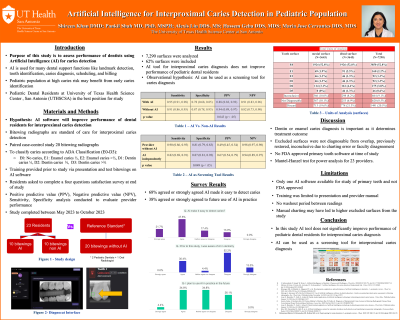Caries
126 - Artificial Intelligence for Interproximal Caries Detection in Pediatric Population

.jpeg.jpg)
Shireen O. Khan, DMD
Resident
University of Texas —San Antonio, San Antonio, TX
University of Texas Health Science Center San Antonio
SAN ANTONIO, Texas, United States- PS
Pankil Shah, M.D, Ph.D., M.S.P.H.
University of Texas Health Science Center San Antonio
- JL
Jungyi Alexis Liu, DDS
Loma Linda University
- HG
Hassem Geha, D.D.S., M.D.S.
University of Texas Health Science Center San Antonio
- MC
Maria Jose Cervantes Mendez, DDS
University of Texas Health Science Center San Antonio
- MC
Maria-Jose Cervantes Mendez, DDS MS FAAPD
Program Director
UTHSCSA
San Antonio, Texas, United States
Presenting Author(s)
Co-Author(s)
Program Director(s)
Purpose: To investigate impact of artificial intelligence (AI) on positive predictive value (PPV) for interproximal caries in the pediatric population by residents.
Method: Residents in the Pediatric Dentistry department at University of Texas Health Science Center San Antonio are asked to study 20 bitewing radiographs with and without AI to see impact on PPV for dentin caries diagnosis in mixed dentition. 2+1 consensus by Pediatric Dentistry faculty and Oral Maxillofacial Radiologist used as reference test. Residents completed a four-question satisfaction survey at the end of study. Further testing was done to see if AI alone had higher sensitivity or specificity as a screening tool.
Results: AI assisted group had a significantly lower PPV as compared to the un-assisted group with p-value of .043. As a screening tool AI alone has better specificity. The p-value for the specificity was significant at .049. Residents experience before residency ranges from 0 to 6+ years in general dentistry.
Survey results: 68% agreed or strongly agreed AI made it easy to detect caries. 38% agreed or strongly agreed to future use of AI in practice.
Conclusion: AI assisted diagnosis for caries in pediatric patients needs further studies. Majority residents found helpful in caries detection and are interested in future use. Use of AI as a screening tool should be explored for pediatric patients.
Identify Supporting Agency and Grant Number: University of Texas Health Science Center, Developmental Dentistry Department

.jpg)